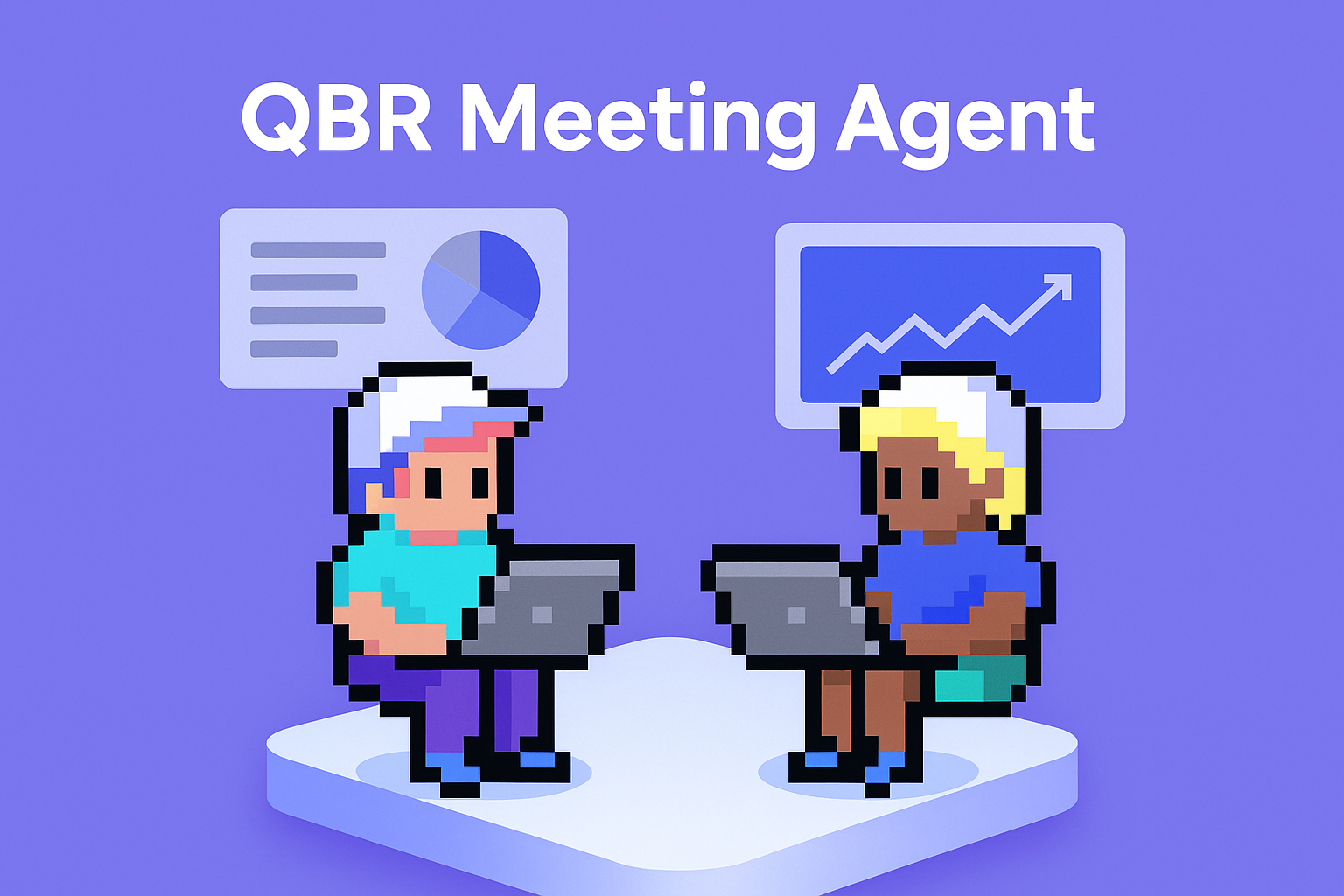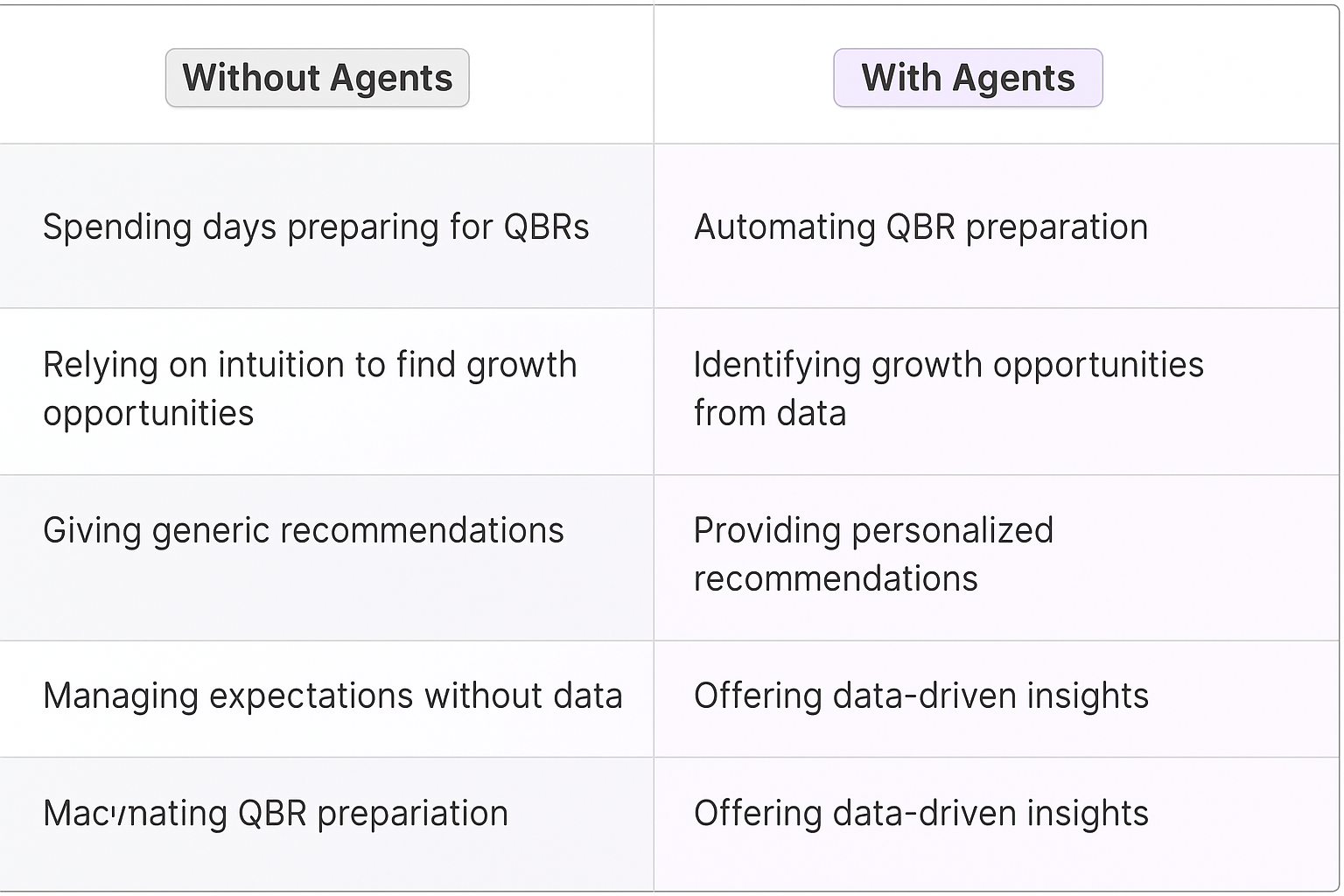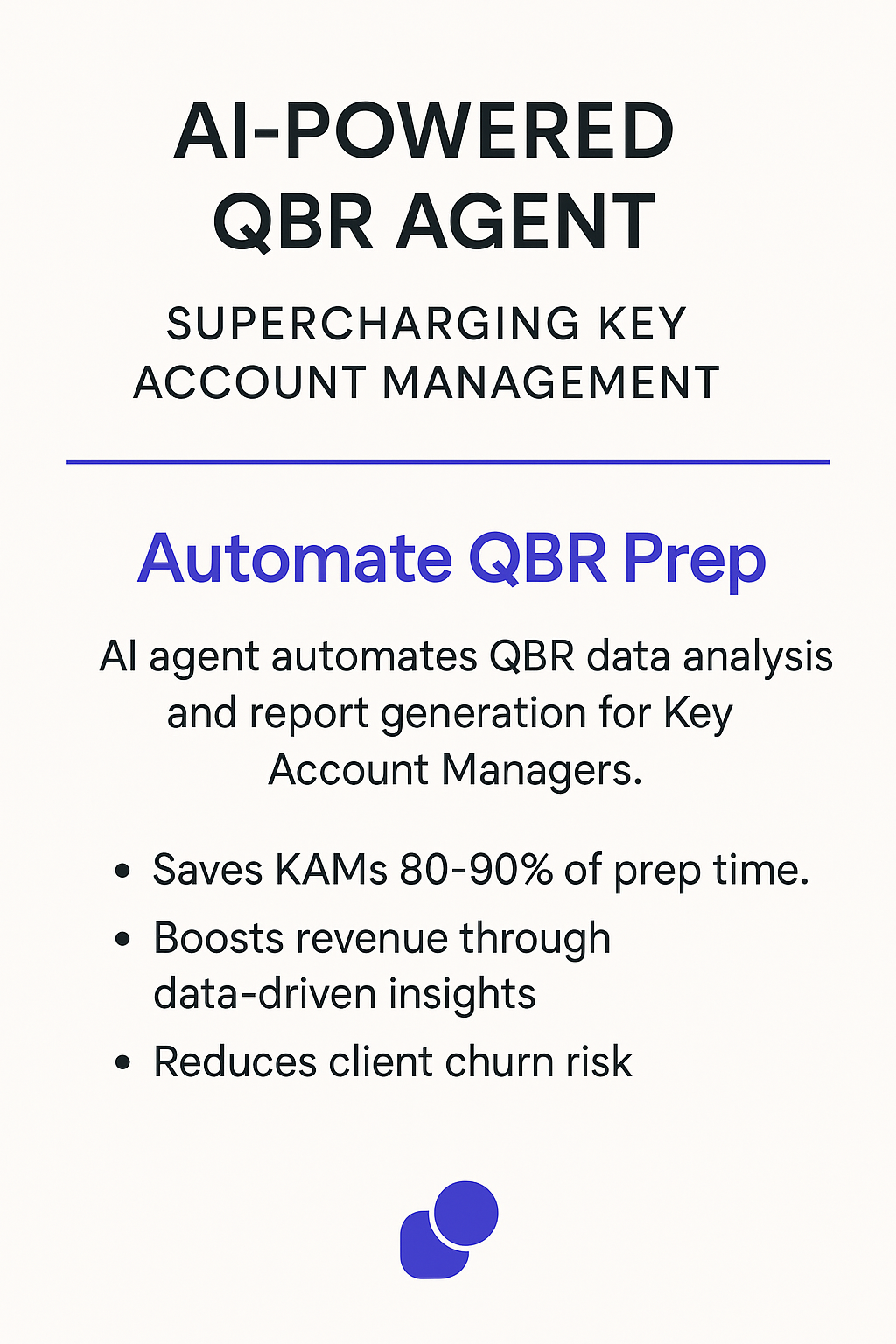
AI-powered meeting planner agents are revolutionizing how Key Account Managers prepare for and conduct Quarterly Business Reviews. These agents automate data analysis, generate strategic recommendations, and streamline the QBR process, allowing managers to focus on building strong client relationships and driving account growth. This technology enhances productivity, improves client satisfaction, and maximizes revenue potential.
Before Meeting
Your AI agent analyzes client performance data, identifies key trends, and generates a comprehensive QBR report. You enter the meeting with a clear understanding of the client's performance and potential growth opportunities.
During Meeting
As you present the QBR, your AI agent provides real-time insights and answers to client questions. It helps you tailor the discussion to address specific client needs and concerns, ensuring a productive and engaging conversation.
After Meeting
Post-QBR, your AI agent generates a summary of key takeaways, action items, and next steps. It helps you track progress on agreed-upon initiatives and ensures that you deliver on your commitments to the client.
What you’ll need
You don't need to be a developer to set up this integration. Follow this simple guide to get started:
- Meeting Notetaker Agent template
- Calendar account
- Meetings to join
- Relevance AI Account

Who this agent is for
This agent is designed for Key Account Managers, Account Executives, Client Success Managers, and anyone responsible for managing and growing relationships with key clients. It's ideal for individuals and teams who conduct regular QBRs to review performance, identify opportunities, and align on strategic goals. Whether you're managing a portfolio of enterprise clients or focusing on strategic partnerships, this agent simplifies QBR preparation and ensures you deliver maximum value to your clients.
How this agent makes QBR planning easier
Automate data analysis and report generation
Instead of manually compiling data from various sources, the agent automatically analyzes client performance metrics and generates a comprehensive QBR report. This saves significant time and reduces the risk of errors.
Identify key trends and insights
The agent uses AI to identify key trends and insights in client performance data, highlighting areas of success and areas for improvement. This helps you focus your attention on the most important issues and opportunities.
Generate strategic recommendations
Based on the data analysis, the agent generates strategic recommendations for account expansion, upselling, and cross-selling. This provides you with a clear roadmap for driving client growth.
Personalize the QBR presentation
The agent allows you to customize the QBR presentation to address specific client needs and concerns. This ensures that the presentation is relevant and engaging for each client.
Benefits of AI Agents for Key Account Managers
What would have been used before AI Agents?
Key Account Managers traditionally relied on manual data collection, spreadsheet analysis, and subjective assessments to prepare for QBRs. This process was time-consuming, prone to bias, and often lacked the depth of insight needed to drive meaningful client outcomes. They would spend countless hours compiling reports, creating presentations, and trying to identify key trends and opportunities.
What are the benefits of AI Agents?
AI agents offer a streamlined and data-driven approach to QBR preparation, freeing up Key Account Managers to focus on building relationships and driving strategic initiatives. The most significant benefit is the time saved by automating data analysis and report generation. The agent handles everything from data collection to insight generation, reducing the administrative burden on the manager.
AI agents also provide more objective and comprehensive insights by analyzing large datasets and identifying patterns that might be missed by human analysts. This ensures that QBRs are based on solid evidence and that recommendations are aligned with client goals. Furthermore, the agent improves communication by providing clear and concise reports that are easy for clients to understand.
By integrating with existing CRM and ERP systems, the agent provides a seamless and user-friendly experience. This eliminates the need for manual data entry and ensures that all QBR-related information is accurately recorded and easily accessible. Ultimately, AI agents enhance productivity, improve client satisfaction, and drive revenue growth for Key Account Managers.
Traditional vs Agentic meeting planning
Traditionally, Key Account Managers spent days preparing for QBRs, manually compiling data and creating presentations. Now, AI agents automate this, freeing up time for strategic client engagement. Before, identifying growth opportunities relied on intuition and limited data. With an agent, opportunities are identified based on comprehensive data analysis. Recommendations used to be generic and one-size-fits-all. Now, they're personalized to each client's specific needs and goals. Managing client expectations was a challenge without concrete data. The agent provides data-driven insights to support discussions and build trust. Finally, manual report creation was prone to errors and inconsistencies. The agent generates accurate and consistent reports automatically.

Tasks that can be completed by a Meeting Planner Agent
Key Account Managers juggle numerous tasks, from building client relationships to developing strategic plans and managing account performance. A meeting planner agent can handle many of the administrative tasks associated with preparing for and conducting QBRs, allowing managers to focus on their core responsibilities.
Analyzing Client Performance Data
The agent analyzes client performance data from various sources, including CRM, ERP, and marketing automation systems, to identify key trends and insights.
Generating QBR Reports
The agent automatically generates comprehensive QBR reports that include key performance indicators (KPIs), trends, and strategic recommendations.
Identifying Growth Opportunities
The agent identifies opportunities for account expansion, upselling, and cross-selling based on client needs and market trends.
Creating Personalized Presentations
The agent creates personalized QBR presentations that are tailored to each client's specific needs and concerns.
Tracking Action Items and Follow-Ups
The agent tracks action items and follow-ups from QBR meetings to ensure that commitments are met and progress is made.
Scheduling and Coordinating Meetings
The agent can schedule and coordinate QBR meetings with clients, taking into account time zones, availability, and preferences.
Sending Automated Reminders
The agent sends automated reminders to clients before QBR meetings to ensure that they are prepared and engaged.
Integrating with CRM and ERP Systems
The agent integrates with CRM and ERP systems to access client data and streamline the QBR process.

Things to Keep in Mind When Building a Meeting Planner Agent
Building an effective QBR meeting planner agent requires careful planning and attention to detail. The goal is to create an agent that seamlessly integrates with your existing workflows and provides a user-friendly experience for both Key Account Managers and their clients.
Define Clear Objectives
Before you start building your agent, define clear objectives for what you want it to achieve. Do you want to reduce QBR preparation time, improve client engagement, increase revenue, or all of the above? Having clear objectives will help you prioritize features and measure success.
Integrate with Existing Systems
Ensure that your agent integrates seamlessly with your existing CRM, ERP, and marketing automation systems. This will allow it to access the data it needs to generate accurate and insightful QBR reports.
Prioritize Data Security
Protect client data by implementing robust security measures. Ensure that the agent complies with all relevant data privacy regulations.
Automate Report Generation
Configure the agent to automatically generate QBR reports on a regular basis. This will save Key Account Managers significant time and effort.
Personalize Recommendations
Allow the agent to personalize its recommendations based on client needs and preferences. This will make the QBR more relevant and engaging for each client.
Test Thoroughly
Before you roll out the agent to your entire team, test it thoroughly to ensure that it is working correctly and that it meets your objectives. Gather feedback from users and make any necessary adjustments.
Continuously Improve
Once your agent is live, continue to monitor its performance and gather feedback from users. Use this information to identify areas for improvement and make ongoing enhancements.
The Future of AI Agents in Meeting Planning
The future of AI agents in QBR planning is bright, with advancements in natural language processing, machine learning, and artificial intelligence promising to further streamline and enhance the QBR process. Future agents will be able to understand complex client needs, anticipate potential challenges, and proactively suggest solutions.
AI agents will also become more personalized, learning individual client preferences and tailoring their recommendations accordingly. They will be able to identify preferred communication styles, preferred meeting formats, and even preferred topics of discussion, creating a more seamless and user-friendly experience.
Furthermore, AI agents will play a larger role in facilitating collaboration and communication during QBR meetings. They will be able to transcribe meeting minutes, track action items, and even provide real-time translation services, making meetings more productive and inclusive.
AI agents will also integrate with other business applications, such as project management tools and CRM systems, providing a holistic view of client-related activities and enabling better decision-making.
Ultimately, the future of AI agents in QBR planning is about creating intelligent systems that not only automate the QBR process but also enhance client relationships, improve communication, and drive better business outcomes.









